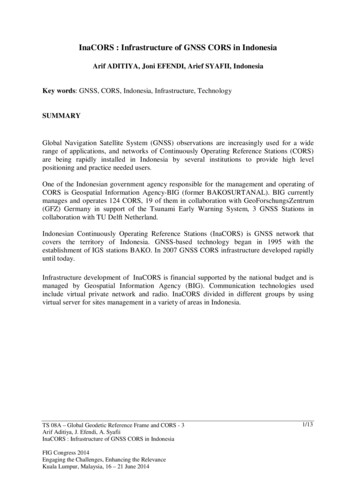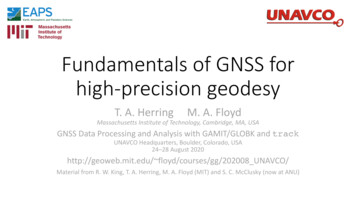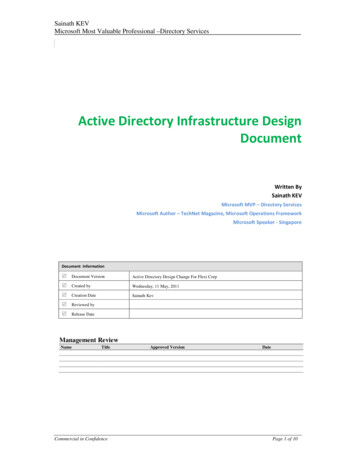
Transcription
InaCORS : Infrastructure of GNSS CORS in IndonesiaArif ADITIYA, Joni EFENDI, Arief SYAFII, IndonesiaKey words: GNSS, CORS, Indonesia, Infrastructure, TechnologySUMMARYGlobal Navigation Satellite System (GNSS) observations are increasingly used for a widerange of applications, and networks of Continuously Operating Reference Stations (CORS)are being rapidly installed in Indonesia by several institutions to provide high levelpositioning and practice needed users.One of the Indonesian government agency responsible for the management and operating ofCORS is Geospatial Information Agency-BIG (former BAKOSURTANAL). BIG currentlymanages and operates 124 CORS, 19 of them in collaboration with GeoForschungsZentrum(GFZ) Germany in support of the Tsunami Early Warning System, 3 GNSS Stations incollaboration with TU Delft Netherland.Indonesian Continuously Operating Reference Stations (InaCORS) is GNSS network thatcovers the territory of Indonesia. GNSS-based technology began in 1995 with theestablishment of IGS stations BAKO. In 2007 GNSS CORS infrastructure developed rapidlyuntil today.Infrastructure development of InaCORS is financial supported by the national budget and ismanaged by Geospatial Information Agency (BIG). Communication technologies usedinclude virtual private network and radio. InaCORS divided in different groups by usingvirtual server for sites management in a variety of areas in Indonesia.TS 08A – Global Geodetic Reference Frame and CORS - 3Arif Aditiya, J. Efendi, A. SyafiiInaCORS : Infrastructure of GNSS CORS in IndonesiaFIG Congress 2014Engaging the Challenges, Enhancing the RelevanceKuala Lumpur, Malaysia, 16 – 21 June 20141/13
InaCORS : Infrastructure of GNSS CORS in IndonesiaArif ADITIYA, Joni EFENDI, Arief SYAFII, Indonesia1. INTRODUCTIONThe use of technologies based on satellite for survey began in the end of 1980. At that timethe use of satellite-based technology is still very limited in the surveying area of horizontaland vertical control network (Abidin et al. 2011).In 1992, Geospatial Information Agency-BIG GPS took part in the survey conducted by theInternational GNSS Service (IGS). Geospatial Information Agency (former NationalCoordinating Agency for Surveys and Mapping-BAKOSURTANAL) is the governmentinstitution that formulates the macro and national level policies governing geospatialinformation in Indonesia. The survey produces 60 GPS stations with zero-order classification.GPS observations on JKHN (National Horizontal Control Network) is calculated zero-order inthe International Terrestrial Reference Frame 1991 (ITRF91) epoch 1992.0(BAKOSURTANAL, 2009)The establishment of GPS Permanent Station network was initiated in 1996 and consisted of 3continuously operating GPS reference system (CORS). There are BAKO station (West Java),SAMP station (North Sumatra) and PARE station (South Sulawesi) (Matindas and Subarya,2009). Afterward followed the installation of other GPS stations in various areas such as Biak(2002), Kupang (2002), and Toli-toli. In March 1998 the GPS station BAKO has registeredIGS (Matindas and Subarya, 2009) and the data can be international free access in CrustalDynamics Data Information System (http://cddis.gsfc.nasa.gov).The installation rapidly grow up began in 2007 by building approximately 25 GPS stations inSunda strains, West Java, Bali and Lombok. Then continue for add installation in 2009 of 10GPS stations in East Nusa Tenggara and 2010 was installed 40 GPS stations in Java island.By supports from the National Budget and Hazard Mitigation Program, BIG succeeded todevelop GPS permanent stations with online system up to 118 stations as illustrated in figure1 (BIG, 2012). Until today BIG operates 124, it consists 102 stations funded from NationalBudget, 19 stations funded from Indonesia-German Cooperation (by means of GermanIndonesia Tsunami Early Warning System program), and 3 stations funded (since 1996) fromDelft University of Technology (TU Delft) for operational GPS station in Palu, Watatu, andToboli (Sulawesi island).TS 08A – Global Geodetic Reference Frame and CORS - 3Arif Aditiya, J. Efendi, A. SyafiiInaCORS : Infrastructure of GNSS CORS in IndonesiaFIG Congress 2014Engaging the Challenges, Enhancing the RelevanceKuala Lumpur, Malaysia, 16 – 21 June 20142/13
Figure 1. The current status of the Indonesian managed by Geospatial Information Agency BIGIn 2011, the Government of Indonesia legitimized the Law number 4 about GeospatialInformation. One of urgency is to encourage the provision and use of one map reference.Infrastructure in support of this one is the availability of a national geodetic control nets in theform of a Continuously Operating Reference Station (CORS). According these laws, BIGencouraged to provide and optimize the use of geospatial data and basic information related toconstruction activities. Figure 2 (Higgins, 2008) shows the organization's role of BIG in themanagement of CORS in Indonesia.Figure 2. A Model for Describing Organisational (Source: Higgins (2008))TS 08A – Global Geodetic Reference Frame and CORS - 3Arif Aditiya, J. Efendi, A. SyafiiInaCORS : Infrastructure of GNSS CORS in IndonesiaFIG Congress 2014Engaging the Challenges, Enhancing the RelevanceKuala Lumpur, Malaysia, 16 – 21 June 20143/13
2. INFRASTRUCTURE OF INACORSThe main purpose of Indonesian Continuously Operating Reference Station (InaCORS) is tomaintain an accurate and precise geodetic reference frame over Indonesian region, and also tosupport a wide range of scientific and practical applications such as geodynamics anddeformation monitoring, meteorological and ionospheric studies and other needs in the frameof surveys and mapping (Abidin et al. 2010). The objectives of main Maintenance ofpermanent GNSS stations network are as follows (Khafid, 2011) : To maintain national geodetic reference frame in active seismic zones for survey andmapping purposes. Mitigation and Crustal deformation monitoring for geological hazard mitigation Sea level change monitoring with continuous GPS and Tide Gauge stations collocation GPS Meteorology to determine PWV in the troposphere and TEC in the ionosphere, Permanent GPS station is part of the Ina-TEWS (Indonesian Tsunami Early WarningSystem) Maintenance of a national geodetic reference frame, which refers to the global geodeticreference frame (ITRF). Service instantaneous correction careful positioning with GPS (RTK) for the purposes ofsurveying and mapping, and other needs. Study geodynamics in Indonesian territory. Mitigation of earthquake disasters.Therefore used geodetic infrastructure and scientific standards have. In this paper,Infrastructure divided into two parts, there are Operations Center and Field EquipmentResource.2.1 Operations CenterAt the Indonesian operation center InaCORS consists of multiple servers with differentfunctions, from receipt of the data, settings, management, storage and services. InaCORSserver placed in the Data Center of Geospatial Information Agency that operates 24 hours aday and 7 days a week. Figure 3 shows the general architecture of InaCORS. Each station isconnected to the communication and transmit data to the server. Then the data is processedand stored in the storage server. The RTK or users need the data can access the through theWeb server or server RTK. BIG has process the GPS data with the scientific software fromMassachusetts Institute of Technology and Scripps Institution of Oceanography scientificsoftware and global software Kalman Filtering (GAMIT / GLOBK) has used the latest versionGAMIT 10.50 (Subarya, 2004) .TS 08A – Global Geodetic Reference Frame and CORS - 3Arif Aditiya, J. Efendi, A. SyafiiInaCORS : Infrastructure of GNSS CORS in IndonesiaFIG Congress 2014Engaging the Challenges, Enhancing the RelevanceKuala Lumpur, Malaysia, 16 – 21 June 20144/13
Figure 3. General Design Architecture of Ina-CORSFigure 4 shows the flow of access (data) starting from the station on the site until access theservice (RTK / Data) by the user. From the image below shows that the InaCORS consistingof various servers. The server is not a physical server but using a virtual machine (VM). Itwill make easy for the management, enhancement and addition of resources in the future.Table 1 describe General Server Specification of InaCORS at Data Center.Figure 4. Access Flow Diagram of Ina-CORSTS 08A – Global Geodetic Reference Frame and CORS - 3Arif Aditiya, J. Efendi, A. SyafiiInaCORS : Infrastructure of GNSS CORS in IndonesiaFIG Congress 2014Engaging the Challenges, Enhancing the RelevanceKuala Lumpur, Malaysia, 16 – 21 June 20145/13
ServerRAMCoreProcessorOSSite Server 1Site Server 2Site Server 3Network serverCluster serverSBC ServerRTK SBC Proxy ServerWeb QC server2 GB2 GB2 GB4 GB4 GB2 GB2 GB4 GB22244224 2.0 GHz 2.0 GHz 2.0 GHz 2.0 GHz 2.0 GHz 2.0 GHz 2.0 GHz 2.0 GHzWin Server 2008 R2Win Server 2008 R2Win Server 2008 R2Win Server 2008 R2Win Server 2008 R2Win Server 2008 R2Win Server 2008 R2Win Server 2008 R2Table 1. General Server Specification of InaCORS2.2 Field Resource EquipmentThe current status of all stations of Indonesian CORS receivers system incorporates the highprecision L1/L2 geodetic type (i.e. GRX1200 family, Topcon NetG3/NetG3A, andSeptentrio) with standard Choke Ring antenna and most of the GPS receivers equiped withmeteorological sensors (Matindas and Subarya, 2009). In 2013 replacing several brokenreceivers with Leica GR10. Figure 5 and 6 shows several pillars of InaCORS on the groundand on the proof. Average height concrete pillar in the ground surface is 3.5 meters. They useidentification marker contain ID site and site owner information.BAKO stationFigure 5. Several pilars of InaCORS : On the Ground (source : CORS Archieve)TS 08A – Global Geodetic Reference Frame and CORS - 3Arif Aditiya, J. Efendi, A. SyafiiInaCORS : Infrastructure of GNSS CORS in IndonesiaFIG Congress 2014Engaging the Challenges, Enhancing the RelevanceKuala Lumpur, Malaysia, 16 – 21 June 20146/13
Figure 6. Several pilars of InaCORS : On the Proof (source : CORS Archieve)GNSS receiver equipment, meteorological sensors, lightning arresters, modem forcommunication and back up power (UPS) placed indoor. Figure 7 shows the device in the boxand outdoor meteorological sensors.Figure 7. The InaCORS equipment in the site (source : CORS Archieve)The data communication of CORS system is very important. By support goodcommunication, data can be sent optimum. Reliability of the data flows from CORS sitescould expect that the real or near real time tracking data should deliver to the processing oroperational center with a sufficiently small delays. The data communication link from CORSsites streaming real time to operational center by using a license free Spread Spectrum radiooperating in the band from 2.400 GHz to 2.4835 GHz in combination with VPN-IP. (Matindasand Subarya, 2009)TS 08A – Global Geodetic Reference Frame and CORS - 3Arif Aditiya, J. Efendi, A. SyafiiInaCORS : Infrastructure of GNSS CORS in IndonesiaFIG Congress 2014Engaging the Challenges, Enhancing the RelevanceKuala Lumpur, Malaysia, 16 – 21 June 20147/13
In Indonesian CORS widely used types of virtual private network communications (VPN) andradio. CORS of GITEWS used communication type VSAT and Iridium. Table 2 describes ofcommunication which is used in a variety of CORS. Land National Agency Indonesia useseveral communication (Sunantyo, 2013).NoData CommunicationDescription1Virtual Private NetworkNetwork technology that creates a secure networkconnection over a public network such as theInternet.2Radioa technology used for transmission of signals (2,4GHz) by means of modulation andelectromagnetic radiation (electromagneticwaves). These waves pass through the air andcreeping3V-SATUsing radio frequency as the data transmissionmedium transmitted to the satellite (satellite as arepeater) to reach large areas or isolated areas.4IridiumSatellite communications services to low-earthsatellite-type orbits (LEO)Table 2. Communication Type of CORSFigure 8. Application management of InaCORS (source : InaCORS Archieve)The Application manages InaCORS BIG and CORS of National Land AgencyTS 08A – Global Geodetic Reference Frame and CORS - 3Arif Aditiya, J. Efendi, A. SyafiiInaCORS : Infrastructure of GNSS CORS in IndonesiaFIG Congress 2014Engaging the Challenges, Enhancing the RelevanceKuala Lumpur, Malaysia, 16 – 21 June 20148/13
3. APPLICATION OF INACORS IN INDONESIAThe main purpose the utilization of the GPS data from InaCORS is for reference framedetermination has been made since the 1990 (BAKOSURTANAL, 2009). CORS data usageused to determine and maintain the national reference framework with involving deformationelement. Access to information related to InaCORS can be access the websiteinacors.big.go.id. There are available several services such as RINEX download, postprocessing and registration for RTK.Figure 9. Display Web Interface of Indonesian Continuously Operating Reference Station(InaCORS)We also have information geospatial reference system and can be access through the websitesrgi.big.go.id (figure 10). Figure 11 shows Velocities Field in Indonesia during Inter-seismicand Co-seismic from GPS measurements 1992-2009.TS 08A – Global Geodetic Reference Frame and CORS - 3Arif Aditiya, J. Efendi, A. SyafiiInaCORS : Infrastructure of GNSS CORS in IndonesiaFIG Congress 2014Engaging the Challenges, Enhancing the RelevanceKuala Lumpur, Malaysia, 16 – 21 June 20149/13
Figure 10. Display Web Interface of Geospatial Reference System IndonesiaFigure 11. The Velocities Field in Indonesia during Inter-seismic and Co-seismicfrom GPS measurements 1992-2009 (Subarya, 2010)Table 3 the utilization of CORS by dividing into 2 parts, in real time mode and in postprocessing mode (Abidin et al, 2010).Utilization and Function of GPS CORSPost-processing modeThe coordinate reference frame for variousEarly warning system for variouspositioning, surveying
At the Indonesian operation center InaCORS consists of multiple servers with different functions, from receipt of the data, settings, management, storage and services. InaCORS server placed in the Data Center of Geospatial Information Agency that operates 24 hours a day and 7 days a week. Figure 3 shows the general architecture of InaCORS. Each station is











